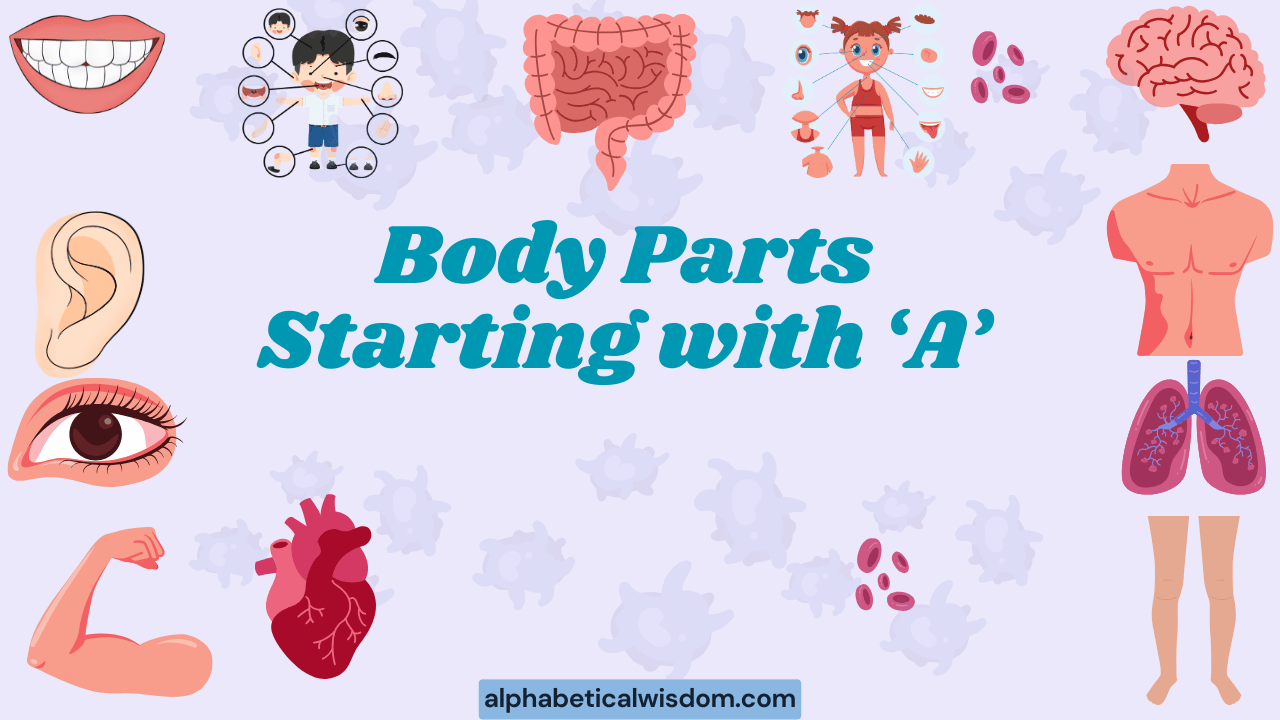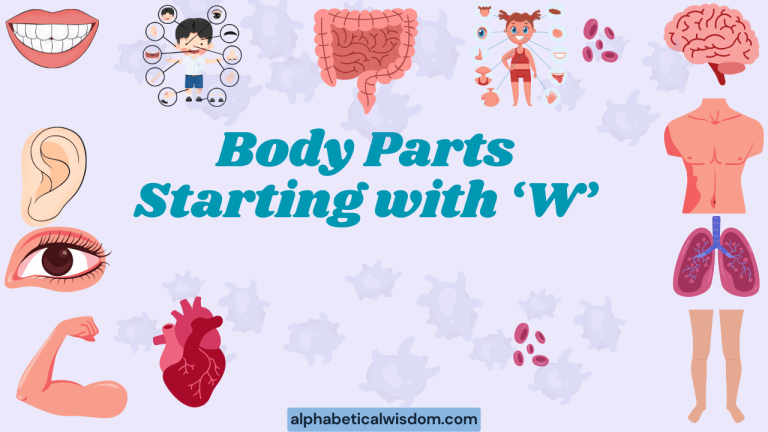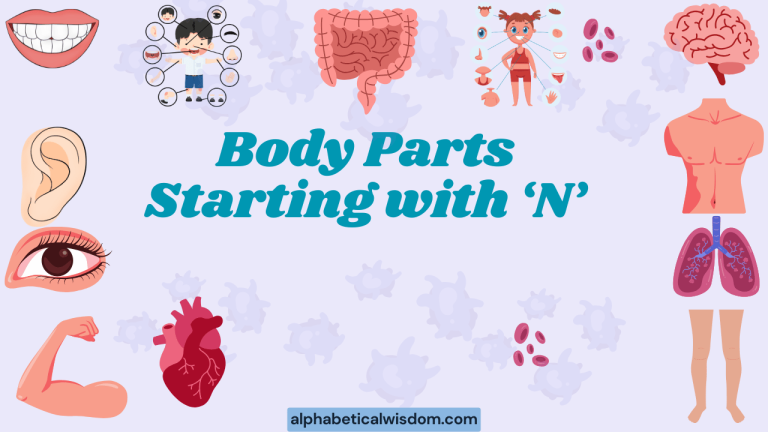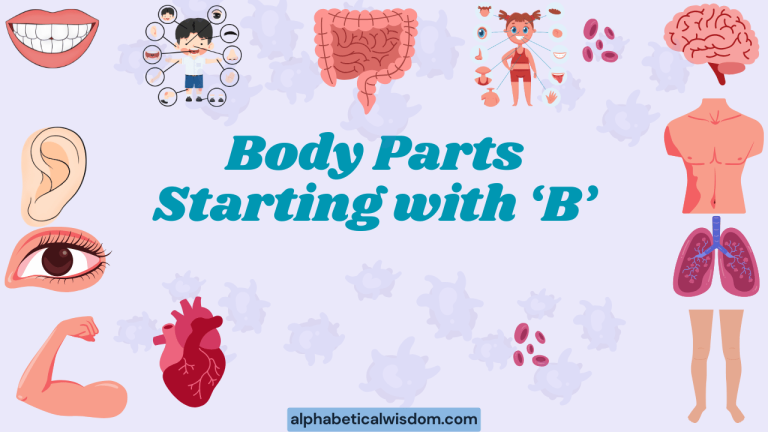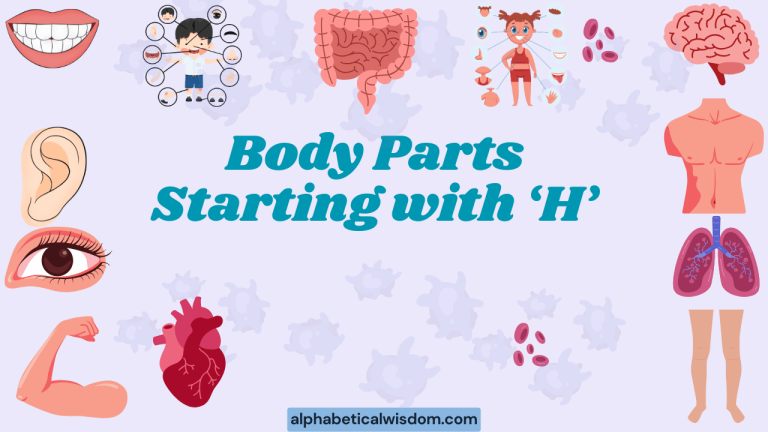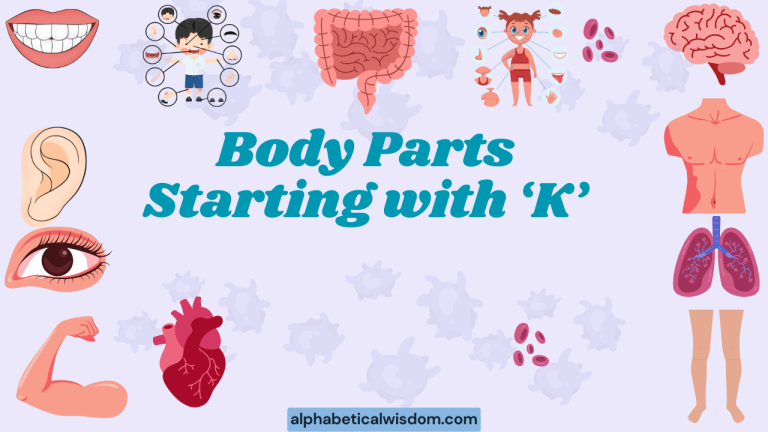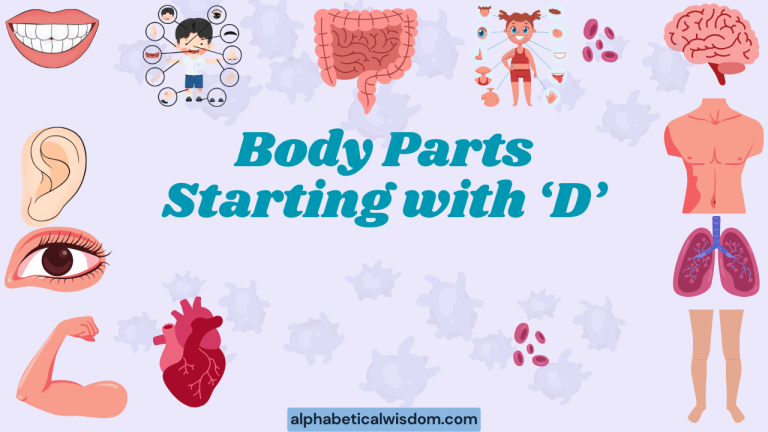Body Parts Starting with ‘A’: A Comprehensive Grammar Guide
Understanding the vocabulary related to body parts is fundamental to English language proficiency. Specifically, focusing on body parts that begin with the letter ‘A’ provides a targeted approach to expanding your lexicon and enhancing your ability to describe the human form accurately.
This article will explore the various body parts starting with ‘A’, delving into their definitions, usage, common mistakes, and providing ample practice exercises to solidify your understanding. Whether you’re a beginner or an advanced learner, this guide offers valuable insights into this specific area of English vocabulary and grammar.
This comprehensive guide is designed for English language learners of all levels, from beginners seeking to expand their basic vocabulary to advanced students aiming to refine their precision in anatomical descriptions. Medical professionals, writers, and anyone interested in enhancing their descriptive language skills will also find this article beneficial.
By mastering the vocabulary of body parts starting with ‘A’, you’ll be able to communicate more effectively and accurately about the human body.
Table of Contents
- Introduction
- Definition of Body Parts Starting with ‘A’
- Structural Breakdown: Anatomical Context
- Types and Categories
- Examples of Body Parts Starting with ‘A’ in Sentences
- Usage Rules and Considerations
- Common Mistakes and How to Avoid Them
- Practice Exercises
- Advanced Topics: Anatomical Terminology & Etymology
- Frequently Asked Questions
- Conclusion
Definition of Body Parts Starting with ‘A’
When discussing body parts starting with the letter ‘A’, we primarily focus on terms related to anatomy, both internal and external. These terms can refer to specific organs, regions, or features of the human body.
Understanding these terms is crucial for clear and accurate communication in various contexts, including medical, scientific, and everyday conversations. We will explore the definitions and classifications of these body parts, highlighting their functions and the contexts in which they are used.
Body parts starting with ‘A’ can be classified based on their anatomical location and function. Some are external, visible features, while others are internal organs responsible for vital bodily processes.
Furthermore, the level of formality in discussing these parts varies depending on the context, ranging from technical medical terminology to informal, everyday language.
Structural Breakdown: Anatomical Context
Understanding the structure and context of body parts starting with ‘A’ involves recognizing their role within the larger anatomical framework. For example, the term ‘arm’ encompasses a complex structure of bones, muscles, nerves, and blood vessels, all working together to enable movement and sensation.
Similarly, ‘arteries’ are vital components of the circulatory system, responsible for transporting oxygenated blood throughout the body. Knowing these structural relationships helps in comprehending the function and significance of each body part.
The structural breakdown also includes understanding the layers and tissues that compose each body part. The skin on the arm, for instance, consists of multiple layers, each with specific functions in protection and sensation.
Arteries, on the other hand, have a layered structure that allows them to withstand the pressure of blood flow. Detailed knowledge of these structural elements is essential for medical professionals and anyone seeking a deeper understanding of human anatomy.
Types and Categories
External Anatomy
External anatomy refers to the body parts that are visible on the surface of the body. These include features like the arms, areas around the eyes, and aspects of the face.
Understanding these terms is essential for describing physical appearance and identifying specific regions of the body.
Common external body parts starting with ‘A’ include: Arm, Armpit, and areas around the Ankle. Each of these plays a distinct role in movement, sensation, and overall physical appearance.
Internal Anatomy
Internal anatomy focuses on the organs and structures located inside the body. These include vital organs like the Arteries, which are crucial for blood circulation, and other internal components that support bodily functions.
Understanding internal anatomy is vital for medical professionals and anyone studying human biology.
Key internal body parts starting with ‘A’ include: Arteries, Atrium (of the heart), and the Appendix. Each of these plays a critical role in maintaining overall health and bodily function.
Examples of Body Parts Starting with ‘A’ in Sentences
The following tables provide examples of how body parts starting with ‘A’ are used in sentences. These examples are categorized to illustrate different contexts and usages, helping you understand how to incorporate these terms into your own vocabulary.
The examples cover both external and internal body parts, as well as different levels of formality, from medical terminology to everyday language. By studying these examples, you can learn how to use these terms accurately and effectively in various situations.
Table 1: Examples Using “Arm”
| # | Sentence |
|---|---|
| 1 | She raised her arm to wave goodbye. |
| 2 | He broke his arm in a skiing accident. |
| 3 | The doctor examined the patient’s arm for any signs of injury. |
| 4 | The baby reached out with its little arm. |
| 5 | He has a tattoo on his left arm. |
| 6 | The athlete strengthened his arm muscles through rigorous training. |
| 7 | She felt a sharp pain in her arm after the fall. |
| 8 | The robot’s arm extended to pick up the object. |
| 9 | He wrapped his arm around her shoulder. |
| 10 | The soldier lost his arm in combat. |
| 11 | She massaged her aching arm. |
| 12 | The construction worker injured his arm while lifting heavy materials. |
| 13 | He flexed his arm to show off his muscles. |
| 14 | The nurse bandaged his injured arm. |
| 15 | The monkey swung from the tree branch using its arms. |
| 16 | She rested her head on her arm. |
| 17 | The tailor measured the length of his arm for the suit. |
| 18 | He pointed with his arm to indicate the direction. |
| 19 | The child clung to his mother’s arm. |
| 20 | The doctor administered the vaccine in his arm. |
| 21 | The weightlifter strained his arm during the competition. |
| 22 | She wore a bracelet on her arm. |
| 23 | The swimmer used his arms to propel himself through the water. |
Table 2: Examples Using “Arteries”
This table focuses on the use of “Arteries” in various sentences. The examples highlight the importance of arteries in the circulatory system and their role in maintaining overall health.
These sentences often appear in medical or scientific contexts.
| # | Sentence |
|---|---|
| 1 | The arteries carry oxygenated blood from the heart to the rest of the body. |
| 2 | Hardening of the arteries can lead to serious health problems. |
| 3 | The doctor examined the patient’s arteries for any signs of blockage. |
| 4 | Maintaining healthy arteries is crucial for cardiovascular health. |
| 5 | The surgeon performed a bypass to reroute blood flow around the blocked artery. |
| 6 | High cholesterol can contribute to the narrowing of the arteries. |
| 7 | The arteries in the brain are particularly vulnerable to damage from high blood pressure. |
| 8 | Regular exercise helps keep the arteries healthy and flexible. |
| 9 | The study investigated the effects of diet on the health of the arteries. |
| 10 | The arteries supply the heart muscle with the oxygen it needs to function. |
| 11 | Atherosclerosis is a disease characterized by the buildup of plaque in the arteries. |
| 12 | The condition affected the arteries in her legs, causing pain and numbness. |
| 13 | The doctor recommended a procedure to widen the narrowed artery. |
| 14 | The health of the arteries is a key indicator of overall cardiovascular health. |
| 15 | Smoking can damage the arteries and increase the risk of heart disease. |
| 16 | The researcher studied the structure and function of the arteries. |
| 17 | The arteries play a vital role in regulating blood pressure. |
| 18 | The patient had a stent placed in his artery to keep it open. |
| 19 | The medication helped to relax the muscles in the walls of the arteries. |
| 20 | The arteries branch out into smaller vessels called arterioles. |
| 21 | The build-up of plaque in the arteries can lead to heart attacks and strokes. |
| 22 | The arteries are essential for delivering nutrients and oxygen to the body’s tissues. |
| 23 | Damage to the arteries can impair blood flow and lead to various health problems. |
Table 3: Examples Using “Armpit”
This table provides examples of how the word “Armpit” is used in sentences. The examples cover various contexts, including hygiene, medical examinations, and everyday descriptions.
Understanding the usage of “armpit” helps in describing specific areas of the body and related conditions.
| # | Sentence |
|---|---|
| 1 | He applied deodorant to his armpit to prevent body odor. |
| 2 | The doctor examined her armpit for swollen lymph nodes. |
| 3 | She felt a lump in her armpit during a self-examination. |
| 4 | The athlete shaved his armpits to improve aerodynamics. |
| 5 | Sweat stains were visible on his shirt around the armpit area. |
| 6 | The nurse took his temperature by placing the thermometer in his armpit. |
| 7 | She experienced discomfort in her armpit after lifting heavy objects. |
| 8 | The rash spread from her armpit down her side. |
| 9 | He felt a sharp pain in his armpit after the vaccination. |
| 10 | The deodorant is designed to keep your armpits dry and odor-free. |
| 11 | The surgery involved removing lymph nodes from her armpit. |
| 12 | He raised his arm, revealing his armpit. |
| 13 | The patient complained of tenderness in his armpit. |
| 14 | She applied antiperspirant to her armpits every morning. |
| 15 | The doctor palpated her armpit to check for abnormalities. |
| 16 | He tucked the towel under his armpit to keep it in place. |
| 17 | The injury caused swelling in his armpit. |
| 18 | She used a razor to shave the hair from her armpits. |
| 19 | The doctor examined the armpit area for signs of infection. |
| 20 | He wiped the sweat from his armpits with a handkerchief. |
| 21 | The rash was concentrated around his armpit and chest. |
| 22 | The lymphatic system drains through the lymph nodes in the armpit. |
| 23 | She felt a throbbing pain in her armpit after the strenuous workout. |
Table 4: Examples Using “Ankle”
This table focuses on the use of “Ankle” in various sentences. The examples highlight different situations where the ankle might be mentioned, such as injuries, sports, and general descriptions.
Understanding the usage of “ankle” helps in describing lower body anatomy and related issues.
| # | Sentence |
|---|---|
| 1 | She twisted her ankle while hiking in the mountains. |
| 2 | The doctor examined his swollen ankle. |
| 3 | He wore a brace to support his weak ankle. |
| 4 | The runner sprained his ankle during the race. |
| 5 | She has a tattoo on her ankle. |
| 6 | The dancer’s ankles were strong and flexible. |
| 7 | He wrapped an ice pack around his injured ankle. |
| 8 | The high heels put a lot of strain on her ankles. |
| 9 | The physical therapist worked on improving his ankle mobility. |
| 10 | She wore an ankle bracelet as a fashion accessory. |
| 11 | The soccer player injured his ankle during the game. |
| 12 | He iced his ankle to reduce the swelling. |
| 13 | The sprain caused severe pain in his ankle. |
| 14 | She stretched her ankles before her workout. |
| 15 | The boot provided good support for her ankle. |
| 16 | He had surgery to repair the ligaments in his ankle. |
| 17 | The swelling in his ankle made it difficult to walk. |
| 18 | She strengthened her ankles with balance exercises. |
| 19 | The doctor recommended resting his ankle. |
| 20 | He used crutches to keep weight off his injured ankle. |
| 21 | The dancer pointed her toes, extending her ankle. |
| 22 | She wore compression socks to support her ankles during long flights. |
| 23 | His ankle felt stiff after sitting for hours. |
Table 5: Examples Using “Appendix”
This table provides examples of sentences using the word “Appendix.” These examples showcase the context in which the appendix is typically discussed, such as in medical scenarios, health discussions, and anatomical explanations. Understanding the usage of “appendix” is useful in health-related conversations and medical contexts.
| # | Sentence |
|---|---|
| 1 | The doctor suspected appendicitis and ordered a scan of the appendix. |
| 2 | The surgeon removed his appendix in an emergency operation. |
| 3 | An inflamed appendix can cause severe abdominal pain. |
| 4 | The patient was diagnosed with appendicitis and needed an appendectomy to remove the appendix. |
| 5 | The appendix is a small, finger-like pouch attached to the colon. |
| 6 | Doctors believe the appendix may have played a role in digestion in our ancestors. |
| 7 | The removal of the appendix is a common surgical procedure. |
| 8 | The appendix is located in the lower right abdomen. |
| 9 | If left untreated, a ruptured appendix can lead to a serious infection. |
| 10 | The scan revealed that his appendix was severely inflamed. |
| 11 | The symptoms of appendicitis include pain, nausea, and loss of appetite caused by the inflamed appendix. |
| 12 | The surgeon made a small incision to remove the appendix. |
| 13 | The patient recovered quickly after the appendix removal surgery. |
| 14 | The appendix does not appear to have a crucial function in modern humans. |
| 15 | The inflammation of the appendix can be life-threatening if not treated promptly. |
| 16 | The doctor explained the risks and benefits of removing the appendix. |
| 17 | She experienced sharp pain that indicated a problem with her appendix. |
| 18 | The appendix is a vestigial organ, meaning it has lost its original function over time. |
| 19 | The emergency room doctor suspected appendicitis due to the patient’s symptoms relating to the appendix. |
| 20 | The surgical team prepared for the appendectomy to remove the infected appendix. |
| 21 | After the surgery, the pathologist examined the removed appendix. |
| 22 | Appendicitis occurs when the appendix becomes blocked, often by stool, a foreign body, or cancer. |
| 23 | The patient was relieved after the successful removal of his problematic appendix. |
Usage Rules and Considerations
When using body part names starting with ‘A’, it’s important to consider the context and audience. The level of formality can vary significantly, and using the appropriate term is crucial for clear communication.
Additionally, idiomatic expressions involving these body parts can add nuance and color to your language.
Understanding the specific anatomical meanings and considering the cultural sensitivity surrounding body parts are essential for effective communication. Below are some specific rules to consider.
Formal vs. Informal Usage
The choice of words can change depending on whether the context is formal or informal. In medical settings, precise anatomical terms are necessary.
In everyday conversation, simpler terms are often used.
For example, in a medical report, one might say “The patient experienced pain in the antecubital fossa,” while in casual conversation, one might say “The patient experienced pain in the inner elbow.”
Medical Terminology
Medical terminology uses specific and precise terms to describe body parts and conditions. Understanding these terms is essential for healthcare professionals and anyone studying medicine.
For example, arteriosclerosis refers to the hardening of the arteries, a condition that can lead to serious cardiovascular problems. It’s important to use these terms correctly to avoid confusion and ensure accurate communication in medical contexts.
Idiomatic Expressions
Many idiomatic expressions incorporate body parts, adding color and nuance to the English language. These expressions often have figurative meanings that differ from the literal meanings of the words.
For example, the phrase “arm in arm” means walking closely together, showing affection or solidarity. Understanding these idiomatic expressions can enhance your comprehension and fluency in English.
Common Mistakes and How to Avoid Them
Learners often make mistakes when using body part names, particularly when it comes to spelling, pronunciation, and context. Recognizing these common errors and understanding how to correct them can significantly improve your accuracy and confidence.
Here are some common mistakes and how to avoid them:
- Misspelling: For example, spelling “artery” as “artary.” Always double-check the spelling of anatomical terms.
- Pronunciation: Mispronouncing “armpit” or “ankle.” Use online dictionaries to practice correct pronunciation.
- Incorrect Context: Using a formal medical term in an informal conversation. Choose words appropriate for the audience and situation.
Here is a table illustrating some common mistakes along with the correct usage:
| Incorrect | Correct | Explanation |
|---|---|---|
| I hurted my arm. | I hurt my arm. | “Hurt” is irregular and doesn’t require “-ed” in the past tense. |
| The artery are blocked. | The arteries are blocked. | “Artery” is singular; “arteries” is plural. |
| She has pain in her armpits. | She has pain in her armpit. | If the pain is in one specific location, use the singular form. If it’s on both sides, then armpits is correct. |
| I sprained my ancle. | I sprained my ankle. | Correct spelling of “ankle.” |
| My appendix bursted. | My appendix burst. | “Burst” is the past tense of “burst.” |
Practice Exercises
The following exercises will help you practice using body parts starting with ‘A’ in sentences. These exercises cover various aspects, including vocabulary, grammar, and context.
By completing these exercises, you can reinforce your understanding and improve your fluency.
Exercise 1: Fill in the Blanks
Complete the following sentences with the correct body part starting with ‘A’.
| # | Question | Answer |
|---|---|---|
| 1 | He lifted the heavy box with his strong _____. | arm |
| 2 | The _____ carry blood from the heart. | arteries |
| 3 | She applied deodorant to her _____. | armpit |
| 4 | He twisted his _____ playing basketball. | ankle |
| 5 | The doctor removed his _____. | appendix |
| 6 | The baby reached for the toy with its _____. | arm |
| 7 | Hardening of the _____ can lead to heart disease. | arteries |
| 8 | He felt a lump in his _____. | armpit |
| 9 | She wore a bracelet around her _____. | ankle |
| 10 | An inflamed _____ can cause severe pain. | appendix |
Exercise 2: True or False
Determine whether the following statements are true or false.
| # | Statement | Answer |
|---|---|---|
| 1 | The arteries carry deoxygenated blood. | False |
| 2 | The armpit is also known as the axilla. | True |
| 3 | The ankle connects the foot to the thigh. | False |
| 4 | The appendix plays a vital role in digestion. | False |
| 5 | The arm is part of the upper limb. | True |
| 6 | Arteries carry blood away from the heart. | True |
| 7 | The armpit is located between the arm and the torso. | True |
| 8 | The ankle is only comprised of one bone. | False |
| 9 | The appendix has a crucial function in modern humans. | False |
| 10 | The arm is used for manipulation and grasping. | True |
Exercise 3: Sentence Completion
Complete the sentences using the correct form of the word in parentheses.
| # | Question | Answer |
|---|---|---|
| 1 | The doctor examined the patient’s _____ (arm) after the accident. | arm |
| 2 | The _____ (artery) were clogged, causing chest pain. | arteries |
| 3 | She felt a sharp pain in her _____ (armpit). | armpit |
| 4 | He sprained his _____ (ankle) while playing soccer. | ankle |
| 5 | The doctor recommended removing the _____ (appendix) to prevent further complications. | appendix |
| 6 | The weightlifter strained his _____ (arm) muscles during the competition. | arm |
| 7 | Maintaining healthy _____ (artery) is essential for cardiovascular health. | arteries |
| 8 | She noticed a rash in her _____ (armpit) after using a new deodorant. | armpit |
| 9 | He wore a supportive brace on his injured _____ (ankle). | ankle |
| 10 | The patient was diagnosed with appendicitis, requiring an _____ (appendix) removal. | appendix |
Advanced Topics: Anatomical Terminology & Etymology
For advanced learners, exploring the etymology and precise anatomical terminology can provide a deeper understanding of body parts. This includes understanding the Latin and Greek roots of anatomical terms and their historical context.
For instance, the term “artery” comes from the Greek word “artēria,” meaning “windpipe” or “artery.” This is because ancient anatomists believed that arteries carried air. Understanding these etymological roots can help you remember and understand the meanings of complex anatomical terms.
Delving into the detailed anatomical structures of the arm, the arrangement of arteries, the lymphatic system in the armpit, the complex joint structure of the ankle, and the histological composition of the appendix can offer a comprehensive understanding of these body parts. Advanced learners can also study the variations in anatomical structures and their clinical significance.
Frequently Asked Questions
Here are some frequently asked questions about body parts starting with ‘A’:
- What is the function of arteries?
Arteries carry oxygenated blood from the heart to the rest of the body. They are essential for delivering oxygen and nutrients to the body’s tissues.
- What is the clinical significance of the armpit?
The armpit contains lymph nodes that play a crucial role in the immune system. Swollen lymph nodes in the armpit can indicate infection or other health problems.
- What causes an ankle sprain?
An ankle sprain occurs when the ligaments that support the ankle are stretched or torn, often due to sudden twisting or impact.
- What is appendicitis?
Appendicitis is the inflammation of the appendix, a small pouch attached to the colon. It often requires surgical removal of the appendix.
- Why is it important to maintain healthy arteries?
Healthy arteries ensure proper blood flow and oxygen delivery to the body’s tissues. Maintaining healthy arteries reduces the risk of heart disease, stroke, and other cardiovascular problems.
- What are some common conditions affecting the ankle?
Common conditions affecting the ankle include sprains, fractures, arthritis, and tendonitis. These conditions can cause pain, swelling, and limited mobility.
- Can you live a normal life without an appendix?
Yes, you can live a normal life without an appendix. The appendix is not considered a vital organ, and its removal does not typically cause any long-term health problems.
- What are some risk factors for artery disease?
Risk factors for artery disease include high cholesterol, high blood pressure, smoking, diabetes, obesity, and a family history of heart disease. Lifestyle changes and medical treatments can help manage these risk factors.
- How can I improve the health of my arteries?
You can improve the health of your arteries by maintaining a healthy diet, exercising regularly, avoiding smoking, managing stress,
and controlling risk factors such as high blood pressure and high cholesterol. Regular check-ups with your doctor can also help monitor your artery health.
- What are some exercises to strengthen the ankle?
Exercises to strengthen the ankle include calf raises, heel raises, toe raises, and balance exercises. These exercises can help improve ankle stability and reduce the risk of sprains and other injuries.
Conclusion
Mastering the vocabulary of body parts starting with ‘A’ is a valuable step in enhancing your English language skills. From understanding the precise anatomical terms to using them correctly in various contexts, this guide has provided a comprehensive overview of this topic.
By reviewing the definitions, examples, usage rules, and practice exercises, you can confidently incorporate these terms into your vocabulary and communicate more effectively about the human body. Whether you’re a student, healthcare professional, or simply interested in expanding your knowledge, this guide serves as a useful resource for understanding and using body part names starting with the letter ‘A’.
Remember to practice regularly and continue exploring the fascinating world of anatomical terminology to further enrich your language skills.
